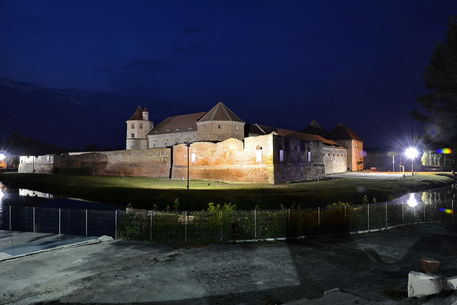This page requires some cookies for the shop functionality, but there are also cookie, that are only used for marketing. Please accept the use of cookies. For more information, look at Privacy Policy
- Sorin Lazar Photography
- Fagaras Fortress
F?g?ra? is a city in central Romania, located in Bra?ov County. It lies on the Olt River and has a population of 28,330 as of 2011.
Romanians now form 91.3% of the population following Saxon and Hungarian emigration, although the city's diverse background is still apparent.
According to linguist Iorgu Iordan, the name of the town is a Romanian diminutive of collective noun *f?gar ("beech forest"), derived from fag, "beech tree".
Another source of the name is alleged to derive from the Hungarian language word for "partridge" (fogor). A more plausible explanation is that the name is given by Fogaras river coming from the Pecheneg "Fagaršu", which means ash water. Another source of the name is given by folk etymology to be Hungarian, as the rendering of "wood" (fa) and "money" (garas), with legends stating that money made of wood had been used to pay the peasants who built the fortress (F?g?ra? Citadel) around 1310.
F?g?ra?, together with Amla?, constituted during the Middle Ages a traditional Romanian local-autonomy region in Transylvania. The first written document mentioning Romanians in Transylvania referred to Vlach lands ("Terra Blacorum") in the Fogaras Region in 1222. (In this document, Andrew II of Hungary gave Burzenlandand the Cuman territories South of Burzenland up to the Danube to the Teutonic Knights.) After the Tatar invasion in 1241–1242, Saxons settled in the area. In 1369,Louis I of Hungary gave the Royal Estates of F?g?ra? to his vassal, Vladislav I of Wallachia. As in other similar cases in medieval Europe (such as Foix, Pokuttia or Dauphiné), the local feudal had to swear oath of allegiance to the king for the specific territory, even when the former was himself an independent ruler of another state. Therefore, the region became the feudal property of the princes of Wallachia, but remained within the Kingdom of Hungary. The territory remained in the possession of Wallachian princes until 1464.
Except for this period of Wallachian rule, the town itself was centre of the surrounding royal estates.
During the rule of Transylvanian Prince Gabriel Bethlen (1613–1629), the city became an economic role model city in the southern regions of the realm. Bethlen rebuilt the fortress entirely.
Ever since that time, F?g?ra? was the residence of the wives of Transylvanian Princes, as an equivalent of Veszprém, the Hungarian "city of queens". Of these, Zsuzsanna Lorántffy, the widow of George I Rákóczy established a Romanian school here in 1658. Probably the most prominent of the princesses residing in the town was the orphan Princess Kata Bethlen (1700–1759), buried in front of the Reformed church. The church holds several precious relics of her life. Her bridal gown, with the family coat of arms embroidered on it, and her bridal veil now covers the altar table. Both are made of yellow silk.
F?g?ra? was the site of several Transylvanian Diets, mostly during the reign of Michael I Apafi.
The church was built around 1715–1740. Not far from it is the Radu Negru high school, built around 1909. It was originally a Hungarian language middle school where Babits Mihály taught for a while.
A local legend says that Negru Vod? left the central fortress to travel south past the Transylvanian Alps to become the founder of the Principality of Wallachia, although Basarab I is traditionally known as the 14th century founder of the state. By the end of the 12th century the fortress itself was made of wood, but it was reinforced in the 14th century and became a stone fortification.
In the beginning of the 20th century, namely in 1910 the town had 6,579 inhabitants with the following proportion: 3357 Hungarian, 2174 Romanian and 1003 German.
F?g?ra?'s castle was used as a stronghold by the Communist State of Romania. During the 1950s it was a prison for opponents and dissidents. After the fall of the Communist State in 1989, the castle has been restored and is currently used as a museum and library.
The city's economy was badly shaken by the disappearance of most of its industries following the Revolution, critical hardships, and reforms. Some of the city population left as guest workers to Italy, Spain, or Ireland. It is one of the poorest municipalities in Romania, as of May 2011.

















